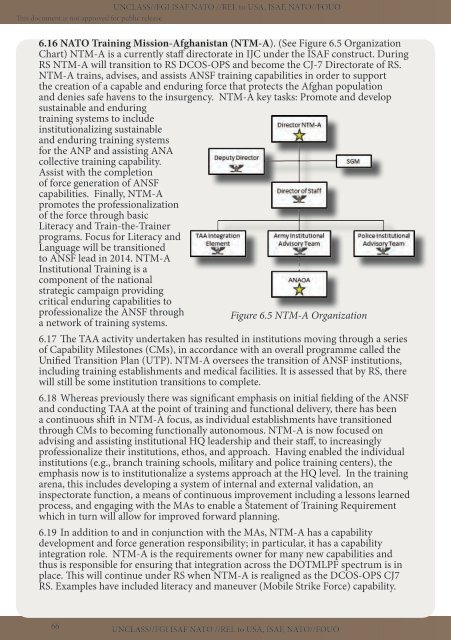20140927_NIU_CJ7_TREX_SFA guide 3.1
20140927_NIU_CJ7_TREX_SFA guide 3.1
20140927_NIU_CJ7_TREX_SFA guide 3.1
You also want an ePaper? Increase the reach of your titles
YUMPU automatically turns print PDFs into web optimized ePapers that Google loves.
UNCLASS//FGI ISAF NATO //REL to USA, ISAF, NATO//FOUO<br />
This document is not approved for public release<br />
6.16 NATO Training Mission-Afghanistan (NTM-A). (See Figure 6.5 Organization<br />
Chart) NTM-A is a currently staff directorate in IJC under the ISAF construct. During<br />
RS NTM-A will transition to RS DCOS-OPS and become the CJ-7 Directorate of RS.<br />
NTM-A trains, advises, and assists ANSF training capabilities in order to support<br />
the creation of a capable and enduring force that protects the Afghan population<br />
and denies safe havens to the insurgency. NTM-A key tasks: Promote and develop<br />
sustainable and enduring<br />
training systems to include<br />
institutionalizing sustainable<br />
and enduring training systems<br />
for the ANP and assisting ANA<br />
collective training capability.<br />
Assist with the completion<br />
of force generation of ANSF<br />
capabilities. Finally, NTM-A<br />
promotes the professionalization<br />
of the force through basic<br />
Literacy and Train-the-Trainer<br />
programs. Focus for Literacy and<br />
Language will be transitioned<br />
to ANSF lead in 2014. NTM-A<br />
Institutional Training is a<br />
component of the national<br />
strategic campaign providing<br />
critical enduring capabilities to<br />
professionalize the ANSF through Figure 6.5 NTM-A Organization<br />
a network of training systems.<br />
6.17 The TAA activity undertaken has resulted in institutions moving through a series<br />
of Capability Milestones (CMs), in accordance with an overall programme called the<br />
Unified Transition Plan (UTP). NTM-A oversees the transition of ANSF institutions,<br />
including training establishments and medical facilities. It is assessed that by RS, there<br />
will still be some institution transitions to complete.<br />
6.18 Whereas previously there was significant emphasis on initial fielding of the ANSF<br />
and conducting TAA at the point of training and functional delivery, there has been<br />
a continuous shift in NTM-A focus, as individual establishments have transitioned<br />
through CMs to becoming functionally autonomous. NTM-A is now focused on<br />
advising and assisting institutional HQ leadership and their staff, to increasingly<br />
professionalize their institutions, ethos, and approach. Having enabled the individual<br />
institutions (e.g., branch training schools, military and police training centers), the<br />
emphasis now is to institutionalize a systems approach at the HQ level. In the training<br />
arena, this includes developing a system of internal and external validation, an<br />
inspectorate function, a means of continuous improvement including a lessons learned<br />
process, and engaging with the MAs to enable a Statement of Training Requirement<br />
which in turn will allow for improved forward planning.<br />
6.19 In addition to and in conjunction with the MAs, NTM-A has a capability<br />
development and force generation responsibility; in particular, it has a capability<br />
integration role. NTM-A is the requirements owner for many new capabilities and<br />
thus is responsible for ensuring that integration across the DOTMLPF spectrum is in<br />
place. This will continue under RS when NTM-A is realigned as the DCOS-OPS <strong>CJ7</strong><br />
RS. Examples have included literacy and maneuver (Mobile Strike Force) capability.<br />
66<br />
UNCLASS//FGI ISAF NATO //REL to USA, ISAF, NATO//FOUO


